InGaAsアバランシェフォトディテクター、自由空間型
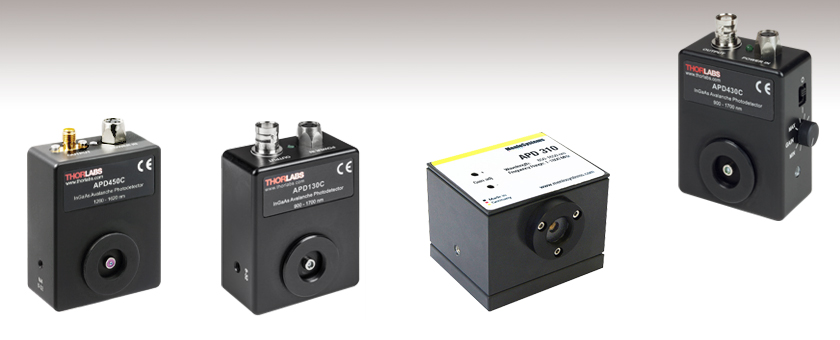
- High-Speed Response up to 1.6 GHz
- Conversion Gains up to 9.0 × 106 V/W
- Wavelength Ranges Covering 850 to 1700 nm
- Temperature-Compensated and Variable Gain Versions Available
APD450C
High Speed, Temperature-
Compensated APD
APD310
High-Speed APD
APD130C
Temperature-Compensated APD
APD430C
Variable-Gain,
Temperature-Compensated APD

Please Wait
| Free-Space InGaAs APD Selection Guide | |||
|---|---|---|---|
| Item # | Wavelength Range | Bandwidth (3 dB) | Type (Quick Links) |
| APD130C(/M) | 900 - 1700 nm | DC - 50 MHz | Temperature Compensated |
| APD410C(/M) | DC - 10 MHz | Variable Gain, Temperature Compensated | |
| APD430C(/M) | DC - 400 MHz | ||
| APD450C | 1260 - 1620 nm | 0.3 - 1600 MHz | |
| APD310 | 850 - 1650 nm | 5 - 1000 MHz | Variable Gain, Temperature Compensated, High Speed |
特長
- 0.12 pW/√Hzまでの低いノイズ等価出力(NEP)
- 3 dBにおける帯域幅:最大1.6 GHz
- 18~28°Cにおける増倍率(M factor)の安定性が≤±3%となる温度補償機能付きモデルもご用意
- 可変利得機能付きディテクタもご用意(M factor:4~20または2~10)
- 自由空間光入射部にはレンズチューブ取付け用のSM05内ネジとSM1外ネジ付き
- AC電源アダプタが付属
当社の自由空間光用InGaAsアバランシェフォトディテクタ(APD)は、標準的なPINディテクタと比べ、感度が高く、低ノイズの性能をご提供します。このAPDは、微弱光レベルの用途に適しています。 また、標準のAPDに加え、可変利得機能付き(M factor)、および温度補償機能付きのAPDもご用意しています。
一般的に、アバランシェフォトディテクタは内部の利得機構を利用して感度を増大させます。高いバイアス電圧をダイオードに印加することで強い電界を発生させます。入射光子によって電子-正孔対が生じると、電界が電子を加速し、衝突電離によって2次電子が発生します。 その結果、電子なだれの状態となり、利得係数は数百倍になります。これは逆バイアス電圧と温度の係数である増倍率(M)で表されます。 一般的に、増倍率は低温になると増大し、高温になると減少します。 同じ様に、逆バイアス電圧を上げると増倍率は上昇し、逆バイアス電圧を下げると低下します。
| Avalanche Photodiode Selection Guidea |
|---|
| Free-Space Si APDs |
| Fiber-Coupled Si APDs |
| Free-Space InGaAs APDs |
| Fiber-Coupled InGaAs APDs |
温度補償機能付きのAPD130C/Mでは、内蔵されているサーミスタの検出値とバイアス電圧が相殺され、温度変化が増倍率(M factor)に与える影響を低減します。 可変利得機能付きAPD410C/M、APD430C/M、APD450Cでは、温度補償機能に加え、筐体側面の回転ノブを使用してダイオードの逆バイアス電圧の調整が可能で、これによって増倍率を4~20に変化させることができます。
さらに高い感度を要する用途には、当社の1 GHzまで高速応答する高感度アバランシェフォトディテクタAPD310をご用意しています。
当社のすべてのアバランシェフォトディテクタのラインナップは「セレクションガイド」タブでご覧いただけます。なお、当社のシングルフォトンディテクタは、唯一単一光子のカウントに適したアバランシェフォトディディテクタです。
| Item # | APD130C(/M) | APD410C(/M) | APD430C(/M) | APD450C |
|---|---|---|---|---|
| Detector Type | InGaAs APD | |||
| Wavelength Range | 900 - 1700 nm | 1260 - 1620 nm | ||
| Output Bandwidth (3 dB) | DC - 50 MHz | DC - 10 MHz | DC - 400 MHz | 0.3 - 1600 MHz |
| Active Area Diameter | 0.2 mm | 75 µm with Ø1.5 mm Ball Lens | ||
| Typical Max Responsivity | 9 A/W @ 1500 nm (M = 10)a | 18 A/W @ 1550 nm (M = 20) | 9 A/W @ 1550 nm (M = 10) | |
| M Factorb | 10 | 4 - 20 (Continuously Adjustable) | 2 - 10 (Continuously Adjustable) | |
| M Factor Temperature Stabilityc | ±2% (Typical); ±3% (Max) | |||
| Transimpedance Gain | 50 kV/A (50 Ω Termination)d 100 kV/A (High-Z Termination) | 250 kV/A (50 Ω Termination)d 500 kV/A (High-Z Termination) | 5 kV/A (50 Ω Termination)d 10 kV/A (High-Z Termination) | 5 kV/A (50 Ω Termination) |
| Max Conversion Gaine,f | 0.9 × 106 V/W | 9.0 × 106 V/W | 1.8 × 105 V/W | 45 × 103 V/W |
| CW Saturation Power | 4.2 µW | 0.45 µW @ 1550 nm (M = 20) 2.25 µW @ 1550 nm (M = 4) | 22 µW @ 1550 nm (M = 20) 110 µW @ 1550 nm (M = 4) | 0.1 mW @ 1550 nm (M=10) 0.5 mW @ 1550 nm (M=2) |
| Max Input Powerg | 1 mW | |||
| Minimum NEPh | 0.46 pW/√Hz (DC - 50 MHz) | 0.12 pW/√Hz (DC - 10 MHz) | 0.45 pW/√Hz (DC - 100 MHz) | 1.1 pW/√Hz (0.3 - 1600 MHz) |
| Integrated Noisei | 3.3 nW (RMS, DC - 50 MHz) | 0.38 nW (RMS, DC - 10 MHz) | 17 nW (RMS, DC - 400 MHz) | 35 nW (0.3 - 1600 MHz) |
| Electrical Output | 50 Ω BNC | 50 Ω SMA | ||
| Max Output Voltage Swing | 1.8 V (50 Ω Termination) 3.6 V (High-Z Termination) | 2.0 V (50 Ω Termination) 4.1 V (High-Z Termination) | 2.0 V (50 Ω Termination) | |
| DC Offset Electrical Output | < ±15 mV | < ±25 mV | < ±3 mV | N/A |
| Included Power Supplyj | ±12 V @ 250 mA (100/120/230 VAC, 50 - 60 Hz, Switchable) | |||
| General | ||||
| Operating Temperature Range | 0 to 40 °C (Non-Condensing) | |||
| Storage Temperature Range | -40 to 70 °C | |||
| Dimensions (H x W x D) | 2.97" x 2.00" x 1.08" (75.5 mm x 50.8 mm x 27.4 mm) | 2.97" x 2.20" x 1.09" (75.5 mm x 55.8 mm x 27.6 mm) | 2.83" x 2.22" x 1.08" (72.0 mm x 56.3 mm x 27.4 mm) | |
| Item # | APD310 |
|---|---|
| Detector Type | InGaAs APD |
| Optical Input | Free Spacea |
| Wavelength Range | 850 - 1650 nm |
| Damage Threshold | 10 mW |
| Active Area Diameter | 0.04 mm |
| Frequency Range | 1 MHz - 1800 MHz |
| 3 dB Bandwidth | 5 MHz - 1000 MHz |
| Rise Time | 500 ps |
| Conversion Gain (Max)b | 2.5 x 104 V/W @ 1 GHz, 1500 nm |
| NEP (Calculated)c | 13.3 pW/√Hz |
| Dark State Noise Leveld | -80 dBm |
| M Factor | 30 |
| Typical Max Responsivity | 0.9 A/W @ 1550 nm |
| Output Impedance | 50 Ω |
| Output Connector | BNC |
| Output Coupling | AC |
| Current Consumption (Max) | 200 mA |
| Supply Voltage | +12 to +15 Ve |
| Operating Temperature | 10 to 40°C |
| Storage Temperature | -20 to +85 °C |
| Storage Humidity | 10% to 90% RH |
| Dimensions | 60 mm x 50 mm x 47.5 mm (2.36" x 1.97" x 1.87") |
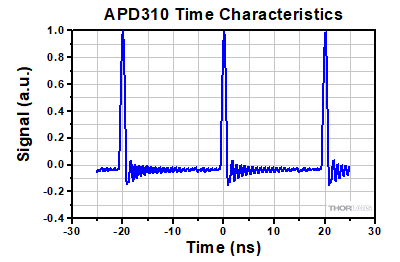
Click to Enlarge
1560 nmのパルス(≤250 fs)列への応答
BNCメス出力(フォトディテクタ)
APDオス(電源ケーブル)
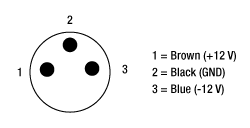
APDメス(フォトディテクタ)
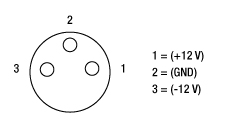
| Components for Fiber Couplinga | |
|---|---|
| Item # | Description |
| - | Free-Space Avalanche Photodetector |
| LM1XY(/M) | Translating Lens Mount for Ø1" Optics |
| SM1L10 | SM1 (1.035"-40) Lens Tube, 1" Long |
| - | Fiber Collimator (Dependent on Fiber) |
| AD11F or AD12F | SM1-Threaded Adapters for Ø11 or Ø12 mm Fiber Collimators (Dependent on Collimator) |
| - | Mounted Molded Aspheric Lens (Dependent on Collimator) |
| S1TM06, S1TM08, S1TM09, S1TM10, or S1TM12 | SM1-Threaded Adapter for Molded Aspheric Lens Cell (Dependent on Lens) |
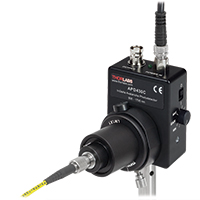
Click to Enlarge
ファイバからの出射光は、信号光をディテクタの受光面に集光するために、非球面レンズを用いてフォトディテクタに結合されています。
自由空間光用アバランシェフォトディテクタにファイバからの出射光を結合する方法
当社の標準的なオプトメカニクスを用いて、ファイバからの出射光を自由空間光用アバランシェフォトディテクタに結合することができます。ファイバ結合においては、ファイバ先端からの出射光の発散を考慮して、全ての信号光をディテクタの受光面に集光することをお勧めします。受光面がØ1 mmより小さいディテクタに対して標準的なファイバーコネクタ用アダプタを使用すると、結合損失が大きくなり、周波数応答特性が低下する場合があります。
高い結合効率を得るには、右の写真のようにファイバーコリメーションパッケージ、集光レンズおよびXY移動マウントを使用する必要があります。写真のアバランシェフォトディテクタでは、ファイバーコリメータ、レンズチューブコリメータアダプタ、レンズチューブ、XY移動マウントが取り付けられています。レンズチューブ内のアダプタで保持されている非球面レンズ(写真では見えません)で、コリメート光がディテクタの受光面に集光されています。また、XY移動マウントで中心合わせができます。
当社ではファイバ結合型SiフォトディテクタAPD431Cもご用意しています。これにはM12 x 0.5ネジ付きフランジが付いており、M12 x 0.5ネジ付きファイバーコネクタアダプタを直接取付けることができます。このコンパクトで堅固な仕組みにより、ファイバ結合を高い再現性で簡単に行うことができます。 M12 x 0.5ネジ付きフランジは、当社のすべてのアバランシェフォトディテクタに追加することができ、それによって堅固なファイバ結合を実現できます。詳細は当社までお問い合わせください。
パルスレーザ:パワーとエネルギーの計算
パルスレーザからの放射光が、使用するデバイスや用途に適合するかどうかを判断する上で、レーザの製造元から提供されていないパラメータを参照しなければならない場合があります。このような場合、一般には入手可能な情報から必要なパラメータを算出することが可能です。次のような場合を含めて、必要な結果を得るには、ピークパルスパワー、平均パワー、パルスエネルギ、その他の関連するパラメータを必要とすることがあります。
- 生物試料を損傷させないように保護する
- フォトディテクタなどのセンサにダメージを与えることなくパルスレーザ光を測定する
- 物質内で蛍光や非線形効果を得るために励起を行う
パルスレーザ光のパラメータは下の図1および表に示します。参照用として、計算式の一覧を以下に示します。資料を ダウンロードしていただくと、これらの計算式のほかに、パルスレーザ光の概要、異なるパラメータ間の関係性、および計算式の適用例がご覧いただけます。
計算式 | ||||
 | 、 |  | ||
 | ||||
 | ||||
 | ||||
平均パワーから算出するピークパワー、ピークパワーから算出する平均パワー : | ||||
 | 、 |  | ||
| 平均パワーおよびデューティーサイクルから算出するピークパワー*: | ||||
 | *デューティーサイクル( ) はレーザのパルス光が放射されている時間の割合です。 ) はレーザのパルス光が放射されている時間の割合です。 | |||
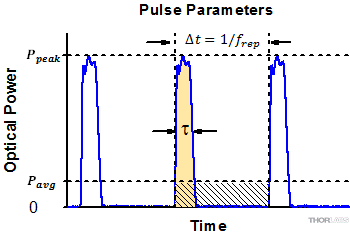
Click to Enlarge
図1: パルスレーザ光の特性を記述するためのパラメータを、上のグラフと下の表に示します。パルスエネルギ (E)は、パルス曲線の下側の黄色の領域の面積に対応します。このパルスエネルギは斜線で表された領域の面積とも一致します。
| パラメータ | シンボル | 単位 | 説明 | ||
|---|---|---|---|---|---|
| パルスエネルギ | E | ジュール[J] | レーザの1周期中に放射される1パルスの全放射エネルギ。 パルスエネルギはグラフの黄色の領域の面積に等しく、 これは斜線部分の面積とも一致します。 | ||
| 周期 | Δt | 秒 [s] | 1つのパルスの開始から次のパルスの開始までの時間 | ||
| 平均パワー | Pavg | ワット[W] | パルスとして放射されたエネルギが、1周期にわたって 均一に広がっていたと仮定したときの、 光パワーの大きさ(光パワー軸上の高さ) | ||
| 瞬時パワー | P | ワット[W] | 特定の時点における光パワー | ||
| ピークパワー | Ppeak | ワット [W] | レーザから出力される最大の瞬時パワー | ||
| パルス幅 |  | 秒 [s] | パルスの開始から終了までの時間。一般的にはパルス形状の 半値全幅(FWHM)を基準にしています。 パルス持続時間とも呼ばれます。 | ||
| 繰り返し周波数 | frep | ヘルツ [Hz] | パルス光が放射される頻度を周波数で表示した量。 周期とは逆数の関係です。 | ||
計算例
下記のパルスレーザ光を測定するのに、最大入力ピークパワーが75 mW
のディテクタを使用するのは安全かどうかを計算してみます。
- 平均パワー: 1 mW
- 繰り返し周波数: 85 MHz
- パルス幅: 10 fs
1パルスあたりのエネルギは、

と低いようですが、ピークパワーは、

となります。このピークパワーはディテクタの
最大入力ピークパワーよりも5桁ほど大きく、
従って、上記のパルスレーザ光を測定するのに
このディテクタを使用するのは安全ではありません。
| Posted Comments: | |
Om Suwal
(posted 2022-07-27 09:24:31.757) Dear sir,
I am looking a fast response ultra sensitive photodetector for CRDS setup. We will use Nd:YAG 1064 nm pulse laser for it. I am thinking to direct focus the signal coming out from one of the mirrors to the photodetector. Larger the active area is better for me. Would you please suggest me appropriate photodetector for it? Thank you! dpossin
(posted 2022-07-27 06:15:54.0) Dear Om,
Thank you for your feedback. I am reaching out to you directly in order to discuss the application with you. Juan Acosta
(posted 2021-10-20 10:26:29.31) Hi,
I would like to know if you can sell just the Housing of the detector without all the electronics just the empty box, with the screws and holes.
Thanks in Advance.
Best Regards
Juan Acosta soswald
(posted 2021-10-21 10:08:46.0) Dear Juan,
thank you for your feedback. I have reached out to you directly to discuss your application in more detail. Darrell Ramsey
(posted 2021-10-19 11:42:36.407) Can the detector be ordered windowless? soswald
(posted 2021-10-21 05:40:27.0) Dear Darrell,
thank you for your feedback. I have reached out to you directly to discuss your application in more detail to see if we can offer a suitable solution. Yaqing Zhang
(posted 2021-05-27 16:37:24.343) Hi,
I am very interested in APD410A and APD430A. From the manual, the typical detector responsivity curves of them only go up to 1000 nm, but I am wondering what they are at 1064 nm.
I really need these data values before I can place my order. Could you please send me the related data or graph? I am grateful for that.
Thanks very much! soswald
(posted 2021-05-31 10:08:53.0) Dear Yaqing,
thank you for your feedback. Unfortunately we have not measured the responsitivity at higher wavelengths than 1000 nm, so we cannot provide those data. soswald
(posted 2021-06-01 09:02:24.0) For 1064 nm sources we would recommend InGaAs instead of Si like in APD410C or APD430C. user
(posted 2018-07-11 11:30:33.107) Hello,
Is it possible to purchase the threaded fiber adapter of the APD310 separately? swick
(posted 2018-07-30 03:47:39.0) This is a response from Sebastian at Thorlabs. Thank you for the inquiry.
We can offer this adapter separately. Please contact techsupport@thorlabs.com for further information. tslim
(posted 2016-12-08 19:38:07.503) I want to use a fiber to couple light into APD410C/M.
I choose F220FC-1064 as the fiber collimator.
How do I choose a suitable aspheric lens? swick
(posted 2016-12-09 03:06:06.0) This is a response from Sebastian at Thorlabs. Thank you for the inquiry.
The lens should be chosen in consideration of optical parameters from your system like optical power, beam diameter and divergence.
In order to recommend a suitable lens for your setup, I have contacted you directly. user
(posted 2016-10-10 14:49:23.927) Regarding the APD430C, is the NEP specified for the gain M=4? If so, what is the NEP for M=20? This is not clear from the specs. swick
(posted 2016-10-11 05:58:49.0) This is a response from Sebastian at Thorlabs. Thank you for the inquiry.
The specified NEP for APD430C is valid for maximum gain (M=20). alekkom
(posted 2016-07-11 20:17:22.35) Hello! I want to measure very low level intensity of light at output of optical fiber. It's equal of 5-100 picowatts. The light is continuous. Wavelength ranges are 500-1000 and 1000-1700 nm. Would you like to offer the detectors for VIS and near IR ranges? shallwig
(posted 2016-07-12 10:52:22.0) This is a response from Stefan at Thorlabs. Thank you for your inquiry. At the moment we can offer silicon Avalanche photo detectors and InGaAs APDs but there are no APDs which cover the full range from 500-1700nm. I have contacted you directly to discuss your application in more detail. j.john.jelen
(posted 2016-02-12 10:07:26.74) I would like to be able to periodically calibrate this APD for use in our lab. Is there a way to do this? Without this, we cannot depend on the measurements.
thank you JJelen shallwig
(posted 2016-02-15 06:34:40.0) This is a response from Stefan at Thorlabs. Thank you very much for your inquiry. At the moment we cannot offer a calibration for amplified photo detectors. The monochromator we use for calibrating our power meter sensors has a diameter of 2mm, only detectors with active area >2mm and fixed gain stage can be offered calibrated. I will contact you directly to discuss your application in detail. user
(posted 2015-05-12 10:23:28.273) I am using APD110C. the problem I have is that the gain is reducing over time and the DC component is keep increasing. Is there a good way to control this? shallwig
(posted 2015-05-22 02:25:47.0) This is a response from Stefan at Thorlabs. Thank you very much for your inquiry, we do not understand the behavior of the APD as described. As you left no contact information could you please contact me at europe@thorlabs.com to troubleshoot this in more detail? Thank you. peupel
(posted 2015-01-30 15:23:31.92) Dear web team,
It would be nice having a direct link to the complete fiber coupling assembly (shown on the right side of product page) rather than several links to general product categories, or at least a list with suggested part number. This would help saving time to order the fiber coupling assembly.
Thanks - Jens shallwig
(posted 2015-01-30 11:51:05.0) This is a response from Stefan at Thorlabs. Thank you very much for your valuable feedback. Our web team will change the related items shown on the right side accordingly your suggestions.
I will contact you directly to check if there is anything else we can help you with. egregorio
(posted 2014-06-05 01:19:11.443) Dear Thorlabs,
I have an APD110C/M InGaAs Avalanche Photodetector. I want to use it for the mesurement of a 1534 nm pulsed laser with 3 mJ (peak pulse), 6 ns (pulse length) at 10 Hz. I need a neutral filter in order to avoid damage to the photodetector. In order to select it, could you indicate me what is the maximum optical input (damage threshold) for a 6ns pulse or similar. What is the saturation input for a 6ns pulse or similar? Thank you. tschalk
(posted 2014-06-06 04:37:05.0) This is a response from Stefan at Thorlabs. Thank you very much for your inquiry. We specify a maximum input power of 1mW for the APD110C. This value is the damage threshold for the photodiode, you can find this information in the spec sheet on our website here:
http://www.thorlabs.com/newgrouppage9.cfm?objectgroup_id=4047
With your pulse parameters this detector is not suitable. The bandwidth of the detector is from DC-50MHz so the repetition rate of your source (10Hz) is no problem. But, the detector would not work linearly for such short pulses (6ns) and the pulses cannot be properly time resolved. I will contact you directly to discuss your application in detail and which alternative detector might fit better. shikin
(posted 2014-05-30 09:18:44.32) Hi! How to use diode responsivity graph for correction of results? shallwig
(posted 2014-06-19 05:55:07.0) This is a response from Stefan at Thorlabs. Thank you very much for your inquiry. With the responsivity R(?) for a given wavelength you can estimate the OUTPUT voltage of the APD110C Avalanche Photodetector. The OUTPUT voltage is a function of incident light power POPT, detectors responsivity R(?),
multiplication factor M and transimpedance gain G given by:
Vout =POPT *R( ?)*M*G
The M-factor of APD110C is factory set to 10 at 23°C ambient temperature.
The amplifier’s transimpedance gain G is 100.000 V/A for all Models APD110C.
Further information can also be found in the manual on page 8 which you can find here: http://www.thorlabs.de/thorcat/19500/APD110C-Manual.pdf
I will contact you directly to discuss your application in detail. sys2643
(posted 2013-07-23 09:11:46.75) Hello
I bought the APD301 Photodetector from your web site.
But I have one problem when I had an experiment.
The problem is that the sensing area of APD301 is very small.
In our experiment, Now, we use 1520nm laser that has a bigger beam size than
the sensing area of APD301.
So, To solve this problem, I'm trying to find another product that can connect to
APD301 such as FPD310 or LENS Tube System.
So, Is it possible to use FPD310 system or lens tube system?
I'm not sure that it is possible to connect FPD310 or lens tube system to APD310.
If not, Do i use another optic system or product?
so if you know methods of products to reduce beam spot size or
increase the sensing size of detector using APD310.
please let me know the method or product.
thank you. cdaly
(posted 2013-07-25 10:45:00.0) Response from Chris at Thorlabs: Thank you for your feedback. The APD310 and PFD310 are each detectors in their own right. If your beam is a bit too large for the APD310 detector, I would suggest focusing it down with an optic, which can be mounted via the SM05 threading on the front. Focusing down to this 30um detector size should be much easier than coupling into the single mode fiber of the FPD310. weinberg.d.j
(posted 2013-03-27 11:10:20.347) Do you have any application notes on using APD110C or APD310 for time correlated single photon counting? My research group would like to look at NIR emission with a decay lifetime of approximately 2 microseconds, but I am not sure if the gain on these APDs will be sufficient. If necessary, we could use a boxcar integrator and collect the voltage output from the APD. tschalk
(posted 2013-04-19 05:16:00.0) This is a response from Thomas at Thorlabs. Thank you very much for your inquiry. Unfortunately we do not provide any application notes for our avalanche Photodetectors. Basically the APDs are not suited for single photon measurements, however we do offer single photon counters (http://www.thorlabs.com/newgrouppage9.cfm?objectgroup_id=5255). I will contact you directly to discuss your application and to find out if the detector is suitable for your needs. jvigroux
(posted 2012-10-04 13:20:00.0) A response from Julien at Thorlabs: Thank you for your inquiry. The rise time of this detector is about 10ns. natalie.haustrup
(posted 2012-10-04 07:44:41.0) Could you please tell me what the rise time of this detector is? jvigroux
(posted 2012-01-25 16:54:00.0) A response form Julien at Thorlabs: Thank you for your inquiry. The M factor can be assimilated to the gain of the detector. The higher the M factor, the higher the gain will be. The statement recommending not using a cell phone within less than 3 meters from the detector is based on a "worst case" scenario. The actual distance within which the power emitted by a mobile phone might be a problem will of course also depends on magnitude of your measurement signal. IF you have any furtehr question, please do not hesitate to contact us at techsupport@thorlabs.com user
(posted 2012-01-24 21:11:22.0) Hi, the APD manual says that different M-factors can be requested. What are the implications of a different M-factor (e.g. M=100) on the performance? Also, the manual states that mobile phones are not allowed within 3 meters (!) of the APD. Is this really required? Thank you. jvigroux
(posted 2011-12-12 07:20:00.0) A response form Julien at Thorlabs: The bandwidth of the APD110 series can be limited to 10kHz if required. I will contact you directly to discuss the details of your request. user
(posted 2011-12-09 13:20:09.0) A response from Tyler at Thorlabs: Thank you for sending us your custom request. I have contacted an application engineer who will work with our production engineers for the product line to see if we can offer a custom detector to meet your needs. alsturl
(posted 2011-12-08 15:35:06.0) I have a picosecond laser signal @5kHz which, after the photodetector, I digitize at 256kHz. Would it be possible to get a custom APD110A with a bandwidth of 10kHz so that the detector isn't faster than the digitizer? And without reducing the NEP or the output voltage into a Hi-Z? Your PDA100A is what I have been using, but I really could use more sensitivity. Thanks! -Adam jjurado
(posted 2011-03-15 18:10:00.0) Response from Javier at Thorlabs to Alex: Thank you for contacting us with your request. A couple of PDA series amplified photodiode detectors are most likely the best best fit for your application. A regular biased DET detector may not be sensitive enough. Also, the APD210/310 avalanche detectors are AC coupled, and, along with the APD110 series detectors, they have a low saturation power (in the order of a few microwatts). Below is a link for these detectors:
http://www.thorlabs.com/NewGroupPage9.cfm?ObjectGroup_ID=4
I will contact you directly to get a better assessment of your application. alekkom
(posted 2011-03-15 21:29:27.0) Hi!
I measure weak light signals of thin optical fiber (2-5 microns core diameter). Wavelengths are 300-1800 nm, light sources are deiterium or galogen lamps. Now I want to change my old detectors. What series of detectors (NON fiber-coupled!!!)are more appropriate for my field? DET, APD210(310) or APD 110 series....
Great thanks!
Alex |
アバランシェフォトディテクタのセレクションガイド
| Item # | Detector Type | Wavelength Range | 3 dB Bandwidth | Active Area Diameter | M Factor | Typical Max Responsivity | Max Conversion Gaina | Variable Gain | Temperature Compensated | Fiber-Coupledb |
|---|---|---|---|---|---|---|---|---|---|---|
| APD440A2 | UV Enhanced Silicon APD | 200 - 1000 nm | DC - 0.1 MHz | 1 mm | 5 - 50 | 25 A/W @ 600 nm (M = 50) | 1.25 x 109 V/W | - | ||
| APD410A2 | DC - 10 MHz | 0.5 mm | 5 - 50 | 25 A/W @ 600 nm (M = 50) | 12.5 x 106 V/W | - | ||||
| APD130A2 | DC - 50 MHz | 1 mm | 50 | 25 A/W @ 600 nm (M = 50) | 2.5 x 106 V/W | - | - | |||
| APD430A2 | DC - 400 MHz | 0.2 mm | 10 - 100 | 50 A/W @ 600 nm (M = 100) | 5.0 x 105 V/W | - | ||||
| APD410 | 5 - 900 MHzc | 0.2 mm | 50 | 22 A/W @ 650 nm (M = 50) | 4.5 x 104 V/Wd | - | ||||
| APD440A | Silicon APD | 400 - 1000 nm | DC - 0.1 MHz | 1 mm | 10 - 100 | 53 A/W @ 800 nm (M = 100) | 2.65 x 109 V/W | - | ||
| APD410A | DC - 10 MHz | 1.0 mm | 10 - 100 | 53 A/W @ 800 nm (M=100) | 26.5 x 106 V/W | - | ||||
| APD130A | DC - 50 MHz | 1 mm | 50 | 25 A/W @ 800 nm (M = 50) | 2.5 x 106 V/W | - | - | |||
| APD430A | DC - 400 MHz | 0.5 mm | 10 - 100 | 53 A/W @ 800 nm (M = 100) | 5.3 x 105 V/W | - | ||||
| APD431A | DC - 400 MHze | 0.5 mm | 10 - 100 | 53 A/W @ 800 nm (M = 100) | 5.3 x 105 V/W | |||||
| APD210 | 5 - 1000 MHzc | 0.5 mm | 100 | 50 A/W @ 800 nm (M = 100) | 2.5 x 105 V/Wf | - | ||||
| APD130C | InGaAs APD | 900 - 1700 nm | DC - 50 MHz | 0.2 mm | 10 | 9 A/W @ 1500 nm (M = 10) | 0.9 x 106 V/W | - | - | |
| APD410C | DC - 10 MHz | 0.2 mm | 4 - 20 | 18 A/W @ 1550 nm (M = 20) | 9.0 x 106 V/W | - | ||||
| APD430C | DC - 400 MHz | 0.2 mm | 4 - 20 | 18 A/W @ 1550 nm (M = 20) | 1.8 x 105 V/W | - | ||||
| APD431C | DC - 400 MHze | 0.2 mm | 4 - 20 | 18 A/W @ 1550 nm (M = 20) | 1.8 x 105 V/W | |||||
| APD450C | 1260 - 1620 nm | 0.3 - 1600 MHz | 1.5 mmg | 2 - 10 | 9 A/W @ 1550 nm (M = 10) | 45 × 103 V/W | - | |||
| APD310 | 850 - 1650 nm | 5 - 1000 MHzc | 0.04 mm | 30 | 0.9 A/W @ 1550 nm (M = 30) | 2.5 x 104 V/Wh | - |

| Key Specificationsa | |
|---|---|
| Item # | APD130C(/M) |
| Detector Type | InGaAs APD |
| Wavelength Range | 900 - 1700 nm |
| Output Bandwidth (3 dB) | DC - 50 MHz |
| Active Area Diameter | 0.2 mm |
| Typical Max Responsivity | 9 A/W @ 1500 nm (M = 10) |
| Transimpedance Gain | 50 kV/A (50 Ω Termination) 100 kV/A (High-Z Termination) |
| Max Conversion Gainb | 0.9 × 106 V/W |
| M Factor | 10 |
| M Factor Temperature Stabilityc | ±2% (Typical); ±3% (Max) |
| Saturation Power (CW) | 4.2 µW |
| Minimum NEP (DC - 50 MHz)d | 0.46 pW/√Hz |
| Dimensions (W x H x D) | 2.97" x 2.00" x 1.08" |
自由空間光用アバランシェフォトディクタAPD130C/Mは、内蔵のサーミスタを用いてアバランシェフォトダイオードのバイアス電圧を補償することで、23 ± 5 ℃における増倍係数(M factor)の変動を±3%以下に抑え、温度が変動する環境下においても優れた出力安定性を発揮します。
機械的および電気的接続の方向と薄型パッケージデザインにより、狭いスペースでもご使用いただけます。本体側面の3面にはM4取付け穴がそれぞれ1つずつ付いているので、複雑な機械的セットアップに簡単に組み込むことができます。またSM05およびSM1シリーズのレンズチューブにも対応しています。SM1内ネジ付きのキャップが1個付属しています。
ファイバ結合の際の注意点:
ファイバ結合の用途において、S120-FCなどのファイバ接続用アダプタにはこのディテクタは小さすぎるため、ご使用をお勧めいたしません。結合損失の増大や周波数応答の劣化につながる可能性があります。高い結合効率を得るにはファイバーコリメーターパッケージ、集光レンズならびにXY軸移動マウントをご使用ください。詳細は「ファイバーカップリング」のタブをご覧ください。

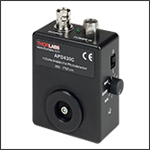
Click to Enlarge
増倍係数(M Factor)はAPD側面のノブで調整可能
- 連続可変利得
- 温度補償設計により、18~28°Cにおける増倍係数(M Factor)の変動を≤±3%に維持
- SM05内ネジとSM1外ネジによりファイバーアダプタやレンズチューブその他の部品を取り付け可能
- AC電源アダプタが付属
自由空間光用アバランシェフォトディクタAPD410C/M, APD430C/MならびにAPD450Cには可変利得機能が付いており、本体右側にあるノブで制御できます。増倍係数(M Factor)は利得ノブでフォトダイオードの逆バイアス電圧を調整することにより、調整できます。上記のディテクタAPD130C/Mと同様、内蔵のサーミスタがアバランシェフォトダイオードのバイアス電圧を補償することで、23 ± 5 °Cにおける増倍係数(M Factor)の変動を±3%以下に抑えます。これらのディテクタはそれぞれ異なる帯域幅と感度でご提供しています。
機械的および電気的接続の方向を考慮した設計と小型のパッケージデザインにより、狭いスペースでもご使用いただけます。APD410C/MとAPD430C/Mの筐体の3面の縁部分にはM4取付け穴がそれぞれ1つずつ付いているので、複雑な機械的セットアップに簡単に組み込むことができます。APD450CはM4/#8-32共通のタップ穴が付いています。また筐体は、当社のSM05およびSM1シリーズのレンズチューブ両方に対応します。SM1内ネジ付きのキャップが1個付属しています。
ファイバ結合の際の注意点:
ファイバ結合の用途において、ディテクタAPD410C/M, APD430C/Mのセンサ部分のサイズが小さいため、S120-FCなどのファイバーコネクタ用アダプタのご使用はお勧めいたしません。結合損失の増大や周波数応答の劣化につながる可能性があります。高い結合効率を得るには、ファイバーコリメーターパッケージ、集光レンズならびにXY軸移動マウントをご使用ください。詳細は「ファイバーカップリング」のタブをご覧ください。
当社ではファイバ結合型SiフォトディテクタAPD431Cもご用意しています。これにはM12 x 0.5ネジ付きフランジが付いており、M12 x 0.5ネジ付きファイバーコネクタアダプタを直接取付けることができます。このコンパクトで堅固な仕組みにより、ファイバ結合を高い再現性で簡単に行うことができます。 M12 x 0.5ネジ付きフランジは、当社のすべてのアバランシェフォトディテクタに追加することができ、それによって堅固なファイバ結合を実現できます。詳細は当社までお問い合わせください。
| Key Specificationsa | |||
|---|---|---|---|
| Item # | APD410C(/M) | APD430C(/M) | APD450C |
| Detector Type | InGaAs APD | ||
| Wavelength Range | 900 - 1700 nm | 1260 - 1620 nm | |
| Output Bandwidth (3 dB)b | DC - 10 MHz | DC - 400 MHz | 0.3 - 1600 MHz |
| Active Area Diameter | 0.2 mm | 75 µm, with Ø1.5 mm Ball Lens | |
| Typical Max Responsivity | 18 A/W @ 1550 nm (M = 20) | 9 A/W @ 1550 nm (M = 10) | |
| Transimpedance Gain | 250 kV/A (50 Ω Termination) 500 kV/A (High-Z Termination) | 5 kV/A (50 Ω Termination) 10 kV/A (High-Z Termination) | 5 kV/A (50 Ω Termination) |
| Max Conversion Gainc | 9.0 × 106 V/W | 1.8 × 105 V/W | 4.5 × 104 V/W (50 Ω Termination) |
| M Factor Adjustment Range | 4 - 20 (Continuous) | 2 - 10 (Continuous) | |
| M Factor Temperature Stabilityd | ±2% (Typical); ±3% (Max) | ||
| Saturation Power (CW) | 0.45 µW @ 1550 nm (M = 20) 2.25 µW @ 1550 nm (M = 4) | 22 µW @ 1550 nm (M = 20) 110 µW @ 1550 nm (M = 4) | 0.1 mW @ 1550 nm (M = 10) 0.5 mW @ 1550 nm (M = 2) |
| Minimum NEPe | 0.12 pW/√Hz (DC - 10 MHz) | 0.45 pW/√Hz (DC - 100 MHz) | 1.1 pW/√Hz (0.3 - 1600 MHz) |
| Dimensions (W x H x D) | 2.97" x 2.20" x 1.09" | 2.83" x 2.22" x 1.08" | |

用途例
- 高速パルスレーザ
- 超低光量信号
- 温度補償型アバランシェフォトディクタ
- RFアンプ内蔵
- 連続調整可能な利得設定
- 長期フィールド試験済み
- 自由空間入力、SM05内ネジ付き
- 使いやすいパッケージ
- 国内用の電源が付属
複数の連続光レーザまたはパルスレーザの間のビート信号検出用に開発されたInGaAsアバランシェフォトディクタAPD310は、850~1650 nmの低い光量の入力信号で高い感度が必要な用途に適しています。APDシリーズのアバランシェフォトダイオードは、従来のPINフォトダイオードよりも高感度です。また高速性も持ち合わせており、例えばナノ秒オーダのパルスレーザの特性評価用にも使用できます。
このディテクタは、温度補償回路により、 10 °C~40 °C動作温度範囲で高利得安定性を維持します。温度補償回路は、降伏電圧付近の動作を確保するために約150 V DCバイアスを調整しています。AC結合デバイスの3 dB帯域幅は、5~1000 MHzです。
可視域(VIS)と、近赤外域(NIR)用のモデルをご用意しております。これらのディテクタはコンパクトな設計なため、組み込み用途(OEM用途)向けにも適しています。
出力の弱いホモダインまたはヘトロダインのビートを信号を、高効率に検出および増幅しなければならない計測手法の研究などの用途に特にお勧めいたします。

- アバランシェフォトディテクタ(上記、型番APD310を除く)の交換用電源
- ±12 VDC出力
- 短絡回路を保護しオーバーロードを防ぐ電流リミット機能
- LED表示付きのOn/Offスイッチ
- AC入力電圧はスイッチ切り替え可能(100/120/230 VAC)
- 長さ2 mのケーブルはLUMBERG製オス型コネクタRSMV3付き
この±12 VDC安定化リニア電源LDS12Bは、型番APD310を除く上記のAPDシリーズのアバランシェフォトディテクタに付属する電源の交換用製品です。 ケーブルに付いているコネクタは3ピンで、グランド用、+12 V用、-12 V用となっています(右図参照)。 また、日本国内仕様の電源ケーブルが付属します。 この電源は当社のPDAシリーズの増幅フォトディテクタ、PDBシリーズの差分フォトディテクタ(バランスディテクタ)、 PMMシリーズの光電子増倍管モジュール、フェムト秒レーザ用オートコリレータFSACにも対応しています。
 Products Home
Products Home













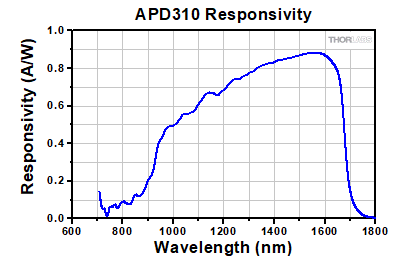
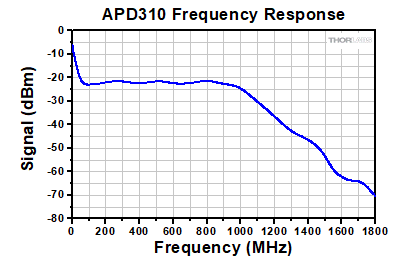
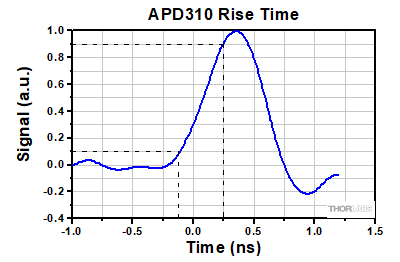
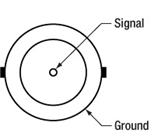

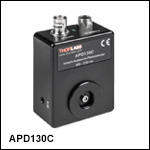
 ズーム
ズーム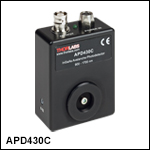
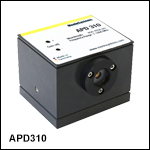
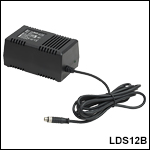

 InGaAs アバランシェフォトディテクタ、自由空間光用
InGaAs アバランシェフォトディテクタ、自由空間光用